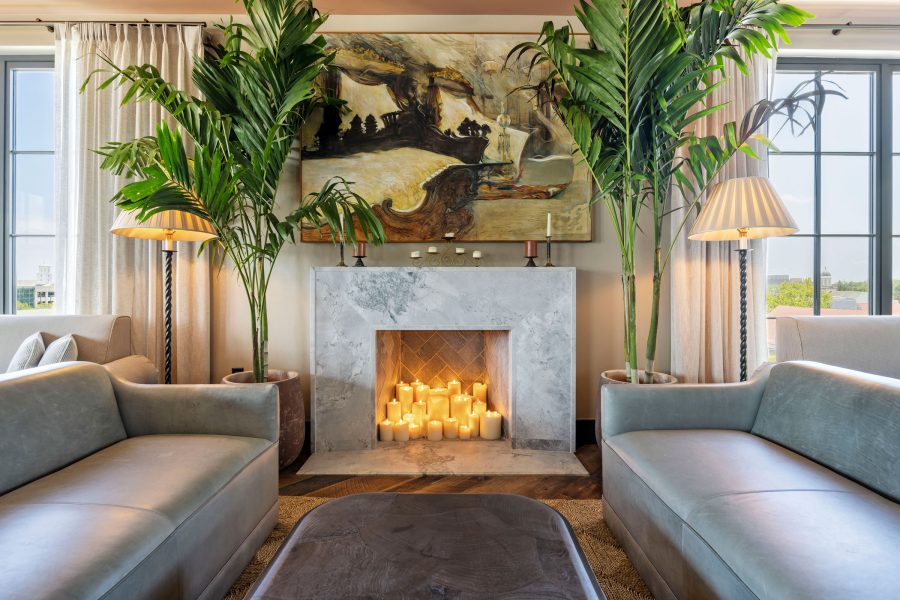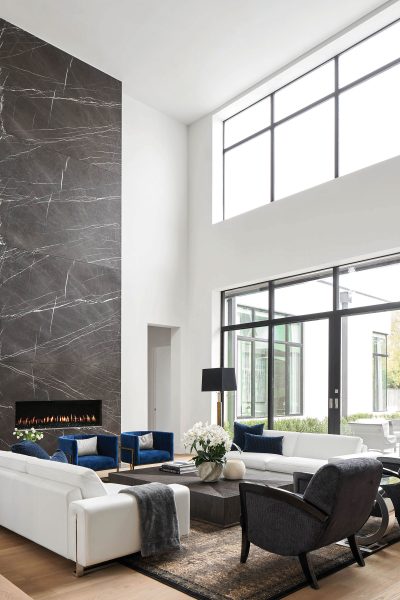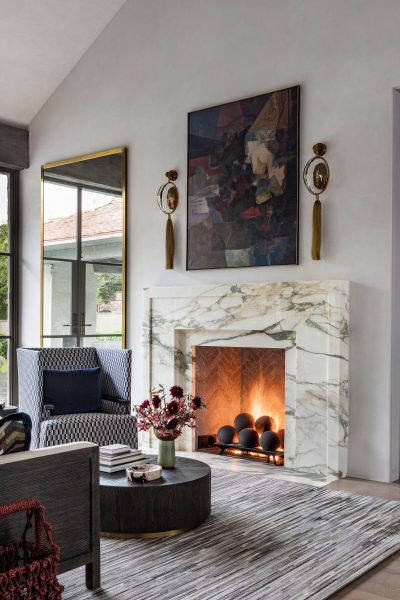Read our featured article on Green Build & Design
By Amber Corrin November 13, 2025

Photo by Chase Daniel, courtesy of Earthcore
Fire prevails in a way almost no other element can emulate. It’s as essential to life as it is destructive; it infinitely bookends human existence. Transfixing for millennia, found in the most archaic texts and belief systems, celebrated, revered, and central to all manner of traditions and survival, it can now also be ignited by merely flipping a switch. Fire perennially dwells in our daily lives.
All of this can be reflected in modern home design and architecture through increasingly advanced technology and sophisticated expression. This is even more true as the latest fireplaces expand far beyond the basic, mass-produced metal boxes often found in homes. The most contemporary varieties jettison any lingering mental images of soot, heavy smoke, or chimney sweeps.
Luxury fireplaces today create experiences—functional art offering an invitation into the heart of a home or bringing a sense of comfort to a hotel lobby or restaurant setting. Some of the most distinctive fireplaces might showcase primeval styling, carved from enormous boulders or composed from expressly sourced volcanic stone, like Isokern.
Fireplaces remain a timeless presence, even as almost everything else about them continues to evolve: their purposes, appearances, placements, composition, and structure. Perhaps it’s ironic, then, that the newest designs utilize ancient elements to create some of the coolest spaces to burn fire.
Icelandic Insulation
- Isokern fireplaces, manufactured from volcanic pumice from Iceland’s Mount Hekla, offer high-quality insulation. Photo by Nathan Schroder Photography, courtesy of Earthcore
- Photo by Julie Soefer Photography, courtesy of Earthcore
Some of the best contemporary fireplaces bridge the profound history and influence of fire and its modern-era housing. That’s part of the mission at Earthcore, whose Isokern offerings use pumice stone from Iceland’s Mount Hekla volcano.
“The volcanic soil we use from the Mount Hekla volcano is quite unique because it’s young. It’s approximately 12,000 years old, whereas most of where you find big volcanic stone or pumice stone mines in America, Greece, Turkey—they’re millions of years old,” says Carl Spadaro, CEO of Earthcore Industries. “The pumice from those regions is very hard, like stone, yet it’s still lightweight—but not as light as the pumice we source from Hekla in Iceland. The aggregate is so full of air, and that’s where the insulation value comes from. It makes for the best insulator.”
Today’s Isokern masonry fireplaces got their start a century ago, with a Danish chimney-cleaning entrepreneur seeking a way to reduce chimney fires and improve insulation from the inside-out. (The product’s name, Isokern, represents key root words: “iso” alluding to equalized insulation, and “kern” meaning “inner.”) Fast-forward to the late 1980s, when Spadaro happened to connect paths with the executives running what had become a full-fledged, Denmark-based company, and the rest is history.
While Spadaro was bullish on Isokern’s unique premise and offerings, he faced an uphill battle as a Florida-based seller of Danish fireplaces made from Icelandic stone, fielding orders from across the country. He mapped out an initial nationwide distribution plan and got to work. “In those early years, none of the big hearth distributors, the big brick companies, the big block companies, the big cement companies—no one wanted to take on this product that nobody ever heard about,” Spadaro says. “Where today we have grown to over 600 distributors and dealers across North America, servicing them through five distribution centers and eight sales and installation offices.”
Innovating in the Industry

Photo by Charleston Real Estate Photography, courtesy of Earthcore
Isokern’s expansion was built on the premise of being the first and leading modular masonry solution for fireplaces in North America. Spadaro says the company offered the only masonry product to carry a UL tested and listed label like those found on refrigerators or washing machines; even today there are few, if any, others, he says.
“What that allowed us to do was prove that the material is so fireproof we can frame up to zero clearance because it doesn’t absorb heat and reflects heat back into the room. In effect our product is so highly refractive and highly insulating that when you burn a fire in an Isokern, whether it’s gas fuel or wood fuel, it’s very efficient,” Spadaro says. “The evolution of our product line was determined by the market. The largest portion of fireplaces in America were basically filing cabinets without the drawers in them, metal boxes with a straw on top. Builders would buy them because they were cheap, but over time things changed.”
Our product is so highly refractive and highly insulating that when you burn a fire in an Isokern … it’s very efficient.
Architects are Isokern’s leading clientele, and the growing popularity of custom masonry fireplaces and the company’s flexible solutions have ushered in a new era. The lightweight, modular fireplaces were able to scale to custom specifications while remaining quick and easy to install.
Expanding on Earthcore’s state-of-the-art automatic production facility in Virginia, Spadaro launched an innovation production laboratory, where the initial product was a patented quick-disconnect linear fuel delivery system. These are very large format fireplace systems that can support demand for architecturally specified commercial projects like resorts, hotels, and large custom residential homes. Many of these require quiet mechanical drafting systems for the fireplaces, and they have that solved with their proprietary mechanical drafting systems, X-Ventiso.
The most recent example of this innovation at work can be found in Isokern’s new Xcelux linear series, offering eight-to-10-foot modular fireplaces. “In the marketplace, if you get an 8-foot metal fireplace, it’s basically like a huge aquarium,” Spadaro says. “They weigh a lot, and you’ve got to pick them up with a crane and get them in somebody’s house. Because we’re modular, I wanted a modular delivery system where I could still send two guys out, and there are six pallets.”
Those pallets, by the way, get recycled—along with any and all leftover stone, leaving no waste behind and contributing to a sub-1% carbon footprint, according to the company.
The Architect’s Perspective

Photo by Tom Harris, courtesy of Prospect Studio
Whether it’s for aesthetics, warmth, or both, having a cozy fire has never gone out of style. But getting a fire going isn’t always easy.
“You have to be a little bit of a Boy Scout to know what you’re doing, and people often want to convert wood-burning into gas units,” says Matthew Thackray, principal at Prospect Studio. “What we often do is specify an Isokern unit, detail the entire thing as if it’s for wood burning, but then also prep it with a propane log set.”
Thackray says the architecture firm likes to give its clients the convenience of gas, but the product doesn’t have to look like an appliance. “There’s real customization and pretty much unlimited adaptability with an Isokern fireplace that can be flexible as our design changes over time,” he says.
Thackray says the evolution of fireplaces has been impressive, with some of the most highly customized, airtight fireplaces available today. Design teams can choose from distinctive fireplaces with pocketing screens and guillotine-style doors or decorative custom steel work with cut boulders as expansive hearth stones.
There’s a lot of fun design expression that feels really rustic and heroic.
“There’s a lot of fun design expression that feels really rustic and heroic,” Thackray says. “We’re getting requests for looks that appear like the house was built around the fireplace, and even though that’s not always the case, it’s still nice. There’s comfort, from an architect’s perspective, that there’s this known functional core in Isokern that can be specified, and we have the freedom to create around that.”
That freedom helps preserve the historic importance of the hearth to the household, “the real heart of the home,” Thackray says, echoing a similar sentiment to Spadaro. The collective work to advance green design and construction also benefits from shared expertise across disciplines and the mutual trust that underpins architectural innovation. For Thackray that includes community work in his Jackson Hole home base in an effort called Building Better in Cold Climates. And for Spadaro it’s continuing to find new approaches to educate and advocate for smart safety and efficiency.
“It’s been over 37 years, I’m not done yet, and we’re innovating even more,” Spadaro says. “At Earthcore I am so proud we have the most knowledgeable people in the industry, and we work diligently to make every Isokern a great experience for our customers. Architects are our number one customer, and they’re the most appreciative of new technology, sustainability, and efficiency. And general contractors appreciate the ease of installation, performance, and affordability. It’s a continuous process, and it’s great.”
View the entire Winter 2025 Green Build & Design issue here.







